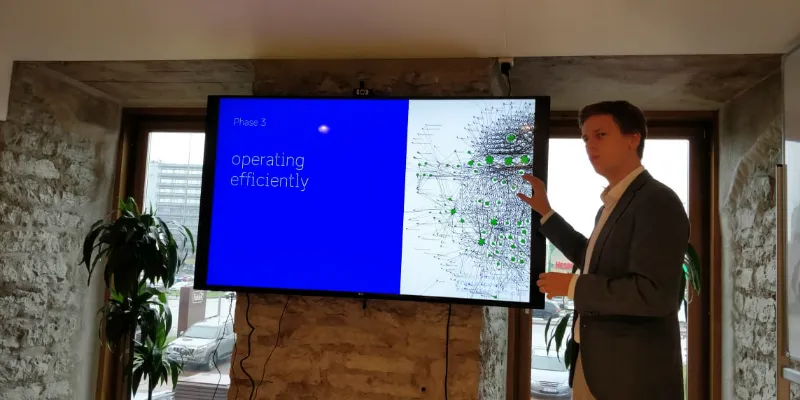How e-Estonia is showing the right way to nations faking digital
With its flagship e-Residency programme, the country enables anyone in the world to apply for an Estonian digital ID card and avail of its e-services.
Estonia’s e-Residency programme has been making news lately here, especially after Mukesh Ambani, India’s richest person, became an e-resident. Estonia launched its e-Residency programme in 2014 and has over 30,000 e-residents from 154 countries till date.
A country of 1.3 million population, Estonia is banking big on digital and, at present, its citizens and e-residents can avail 99 percent services online. With its strong cybersecurity and data protection policies, Estonia is enabling doing business very quick and easy. For example, its unique digital signature project (where you can e-sign documents) saves the country two percent of the GDP.
A recent report released by Deloitte revealed that Estonia’s e-residents have brought €14.4 million back to Estonia in the first three years and this is predicted to rise to €1.8 billion by 2025, which is a return of €100 for every €1 invested in the programme.
Interestingly, Kaspar Korjus, Managing Director of Republic of Estonia’s e-Residency programme, says, “E-Residency was a solution looking for a problem when the programme was launched.”

The programme enables anyone in the world to apply for an Estonian digital ID card and avail of its e-services. It is especially beneficial for entrepreneurs, digital nomads, and freelancers from anywhere in the world looking to do business in the European Union.
In fact, Estonia could be Reliance Jio’s gateway to Europe. Recently, Mint reported that “Reliance Industrial Investments and Holdings Ltd, an investment holding company and a wholly-owned subsidiary of Reliance Industries Ltd (RIL), will give a loan of Rs 12.20 crore (€1.5 million) to the Estonian unit to begin operations.”
YourStory caught up with Kaspar in Tallinn, the capital city of Estonia, to learn more about this Baltic nation’s digital journey and how tech can help in transforming nations.
Faking digital vs digital nation
Just because you can scan documents, send out emails, take printouts and then sign on it and scan again, does not make you digitally advanced. “Estonia was lucky to have bypassed that era,” says Kaspar, adding, “After we regained independence in 1991, we managed to go directly to the second phase.”
In Estonia today, every citizen has a digital identity using which they can access government services digitally. The services applications are user-friendly and not in a cumbersome PDF format. But the true measure of a digital nation, as Kaspar says, is the country’s unique digital signature that saves the country two percent of the GDP.
In 2004, Estonia encountered the next phase of challenges for governance, which is interoperability of data while having a secure data protection policy in place. The country has a decentralised database, and there have to be checks and balances on how data can be exchanged.
Digital Estonia, or e-Estonia, believes in a citizen-centered state and service-oriented information system. Such a system requires information systems to function as an integrated whole to support citizens and organisations. Says, Kaspar, “To do that, different organisations and information systems must be interoperable. Which means they should be able to work together so that data only needs to be requested from the citizen once. Estonia’s solution for
maintaining a modern state is X-Road, which saves Estonians 800 years of working time every year.”
X-Road allows the nation’s various public and private sector e-service databases to link up and function in harmony. Considering 99 percent of Estonia’s services can be accessed online and since each service has its own databases they all use X-Road. “To ensure secure transfers, all outgoing data from X-Road is digitally signed and encrypted, and all incoming data is authenticated and logged,” Kaspar explains.
Illustrating this with an example, Kaspar says, “Last week, I renewed my driver’s licence online. I was asked by the transportation registry if they could get data for my eyesight from my health registry. I said okay. Then they got my data regarding my age etc., from the population registry to know if I was old enough to drive and if I was a citizen of Estonia. And the next day, my driver’s licence was at my doorstep. In the entire process, every time data was transferred I could see who had checked my particular data.”
He adds that citizens have the other option of going physically to avail a service, but with 12 years of using digital, everyone trusts the system.
Who controls my data?
Trust is crucial for a system like this to work. Unless the citizens trust it, no one will use it. Kaspar says, “As you can see from my example, I control my own data. The government cannot access it without my knowledge.” Each of these transactions leaves a digital footprint on a blockchain-based system. Thus, data protection, privacy, and security laws have to make sure who has the legal right to a citizen’s data.
There have been cases in Estonia when a person or organisation not authorised to access data have been penalised. “A police personnel recently lost his job when he was found to be checking his former girl friend’s data to know where she lived. And though the police have a right to check data of a citizen if the latter is involved in a traffic violation or related crime, checking out someone’s data for no reason is punishable,” says Kaspar. If there are legal
balances and checks, the system becomes efficient.

Becoming borderless
Taking digital to the next level, Estonia came up with its e-Residency plan. “If we can offer all services to Estonians around the world, why not extend it to the others,” says Kaspar on the genesis of the e-Residency programme, where anyone from around the world can become an e-resident of Estonia and avail all its services online, including setting up a business there.
He reveals that though when they started this in 2014, they were not clear if anyone will buy the idea. “But we saw an exponential growth, mostly from people who use it for business-related purposes -- they establish EU companies, EU banking accounts, and Amazon accounts to sell in EU. “For us, what this means is that we make new friends and cultural ambassadors of our nation,” says Kaspar.
Moving to the cloud
E-Estonia’s digital embassy programme is a unique initiative. Now, suppose there’s a natural disaster or a political crisis. What happens to the citizens’ data? “If there is a crisis like this, we need to ensure not only the safety of the data but also that all the services are up and running as usual,” says Kaspar. To enable this, Estonia has what is called the data embassy in Luxembourg. “So even if there was a political crisis, as it has happened earlier, our nation will still be up and running,” he adds.
This leads to the question of whether in future we need to redefine the meaning of a nation-state. If you do not need citizens to be physically present in the country since you can have digital subscribers, then nation-states become like a service provider, like a community. “Of course, we wish we do not have to actually fall back on the digital embassy programme, but it is good, it is there,” Kaspar adds.
Becoming invisible
Stating that the role of the government should not be to hassle citizens unnecessarily, Kaspar says we need to figure out how governments can raise funds besides taxation. In a recent blog post, he had asked, “What would happen if a country such as Estonia decided to launch its own crypto tokens with an Initial Coin Offering (ICO). We nicknamed these proposed tokens ‘estcoins’ and explained how e-Residency would provide the platform for distributing and trading them globally because it’s a secure digital identity that anyone in the world can apply for.”
Kaspar says that though this idea raised a lot of questions and people debated both for it and against it, the idea behind estcoins was to raise money and support for the nation’s development from more people around the world. “We would also want to structure the tokens so that they help build our e-resident community and incentivise our own key objective, which is to increase the number of companies started in Estonia through e-Residency,” he wrote in his blog.
Coming back to the government involvement, the advantage with going digital is that government decisions can be based on data and not emotions. “We are building AI-based services systems and processes, and will back it up with strong legal processes,” adds Kaspar.
(YourStory was in Estonia this month at the invitation of the e-Residency programme)







